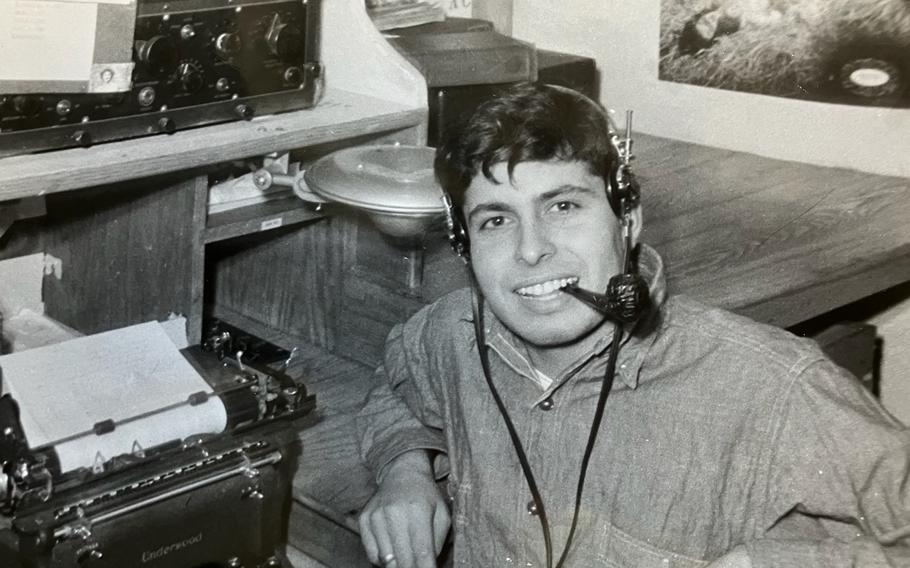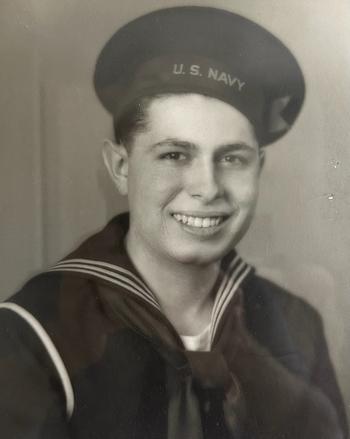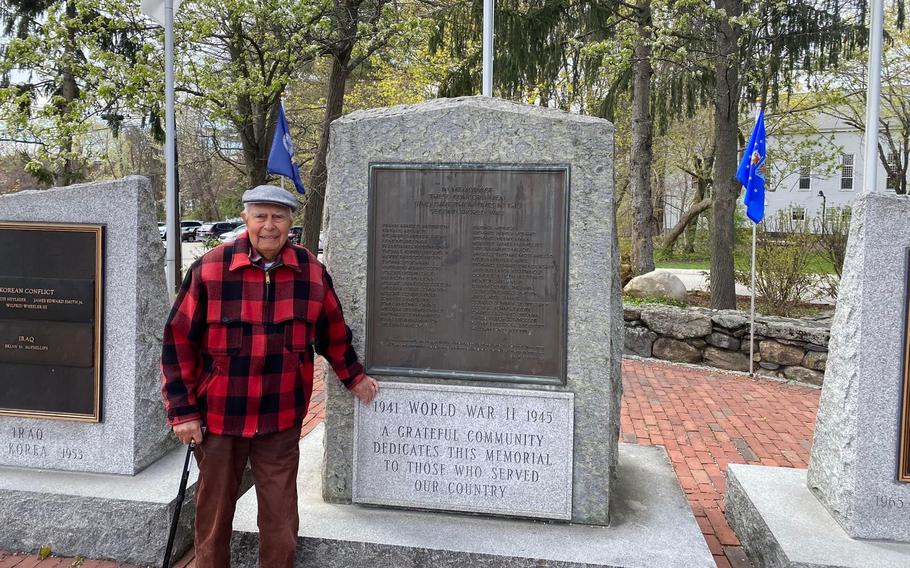
Peter Orlando in the radio room aboard the USS ATR-2 in 1944. A U.S. Navy radio man during World War II, Orlando watched the events of D-Day unfold from afar. (Courtesy of Peter Orlando)
Standing at the rail of his tugboat, U.S. Navy radio man Peter Orlando could hear the deadly clatter of machine guns and see the black smoke billowing from explosions 1,000 yards away on Omaha Beach. Fourteen-inch artillery shells screamed over his head, fired from battleships at German targets above the Normandy coast.
Now 101, Orlando has a clear memory of those harrowing moments of June 6, 1944, as American soldiers waded ashore in France to liberate Europe from the Nazis. He is one of only a handful of World War II veterans alive today who witnessed what happened on D-Day 79 years ago.
“With the passing of the last veterans, we lose a final link with that awesome generation and America’s finest hours,” said Alex Kershaw, an author and resident historian at Friends of the National World War II Memorial, a D.C.-based nonprofit organization. “More than ever we should cherish the last few survivors and what they achieved — the longest period of freedom and peace in European history.”
Orlando, who lives in Concord, Mass., said he is proud of his role.
“If I had to do it again,” he said in a recent interview, “I definitely would.”
Orlando served on the USS ATR-2, an oceangoing rescue tug with the mission of towing damaged and stuck landing craft away from shore. As dawn broke on D-Day, he recalls, his vessel was a short distance from the carnage on Omaha Beach, well within reach of enemy fire.
“I was only 22 and too dumb to be scared,” Orlando said. “We were only 1,000 feet from the shore. I was standing on the bow like in the movie ‘Titanic.’ An officer saw me out there and hollered, ‘Orlando, get the f--- in here!’”
Born in Boston to Italian immigrants, Orlando enlisted in the Navy in 1942. His father served in the U.S. Navy during World War I, and his grandfather had served in the Italian navy.
“I grew up on the beach in South Boston,” Orlando said. “I was always salty, so I figured a life at sea was for me.”

Orlando in 1943, after basic training. (Courtesy of Peter Orlando)
After basic training, Orlando learned to be a radio operator, then was assigned to serve in what was known as the “Dungaree Navy,” a moniker given to smaller ships working in coastal waters. Since there was no official uniform, the men wore standard-issue bell-bottom blue jeans while on duty. They usually turned black, Orlando said, because of the oil and grease from the engine room.
Orlando was one of thousands of sailors prepared to take part in salvage operations on D-Day, a crucial job of removing damaged landing craft and other vessels as quickly as possible so that men and materials could continue toward the beaches unimpeded. Much of the work had never been done before.
“Troops were put ashore in huge amphibious assaults, and the transporting ships and craft sustained damage and required salvage service. Landing craft and ships required an entirely new kind of salvage,” Charles A. Bartholomew and William I. Milwee Jr. wrote in their 2009 book “Mud, Muscle, and Miracles: Marine Salvage in the United States Navy.”
Orlando and his shipmates on the cramped ATR-2 departed Weymouth, England, on the night of June 5 and joined an Allied armada of 5,000 ships headed for France. The next day, they were deployed to assist stranded landing craft but were not needed.
Orlando watched from the sea as death and destruction descended on Omaha Beach, where the U.S. Army’s 1st and 29th infantry divisions suffered 2,400 casualties on June 6 — the most losses of any of the landing zones.
He also witnessed tragedy up close. The seas were rough as soldiers descended large transport ships into smaller landing craft and amphibious trucks, some of which were swamped by waves. Orlando can picture floating bodies: men who drowned before help could reach them.
“We went over and started to pull them from the water,” Orlando said. “We had six or eight on the fantail, which is the rear of the tug. Then we were ordered not to pull up any more, because we had no room for them. I’ll always carry in my mind all the GIs who drowned.”
Orlando’s strongest memory from D-Day came as he watched the landings, wondering what might happen to the men heading into harm’s way. He recalls a dreary day painted by the intense gray of ships, sea and clouds, before he looked up and saw a flash of color: red, white and blue, straight out in a strong wind. He said he has never felt prouder of his country.
Orlando and his crewmates readied for Operation Mulberry, a top-secret plan to assemble floating concrete harbors at two landing sites off Normandy. The artificial harbors provided protection from the sea so landing craft and barges could unload supplies and soldiers for the advancing Allied armies. Orlando’s tug removed explosives and obstacles along the shoreline so the concrete forms could be sunk in place without damage.
The radio man spent the next 100 days patrolling the Normandy coast, defusing explosives, removing wreckage and helping to repair the artificial harbors after storms damaged them. He worked the radio on regular shifts, then assisted the rest of the crew members as they towed stuck and stranded ships from the shore. When a vessel was too damaged to be saved, underwater demolition experts destroyed it with explosive devices.
“Our tug had two 3-inch cannons and 20-millimeter antiaircraft guns,” Orlando recalled. “We used them, too, to blow up ships that were stuck in the way.”
Most of the time, the crew was safe on the tug, which was 168 feet long and 33 feet wide. Their biggest fear was hitting a German mine that had been missed by minesweepers. Once, during an air raid, a German plane dropped a bomb that hit the deck but caused little damage.
“Another time, we were pulling a ship off the beach when the cable got tangled,” Orlando said. “Our tug started to (tip over), and I thought we were going under. Fortunately, one of the divers went over the side and cut the line in the nick of time.”

Orlando visits Monument Square in Concord, Mass. (Courtesy of Peter Orlando)
After D-Day, the Allies went on to liberate Europe and defeat the Nazis. Orlando returned home, learned photography on the GI Bill, married and raised a family in Concord, a town about 20 miles west of Boston where Revolutionary War history was made.
Orlando still lives in Concord, in an assisted living facility. He visits a local coffee shop once a week for a slice of blueberry pie with vanilla ice cream. He uses reading glasses, but he is in good health.
“Just had my physical,” he said last month. “The doctor said he’ll see me next year.”